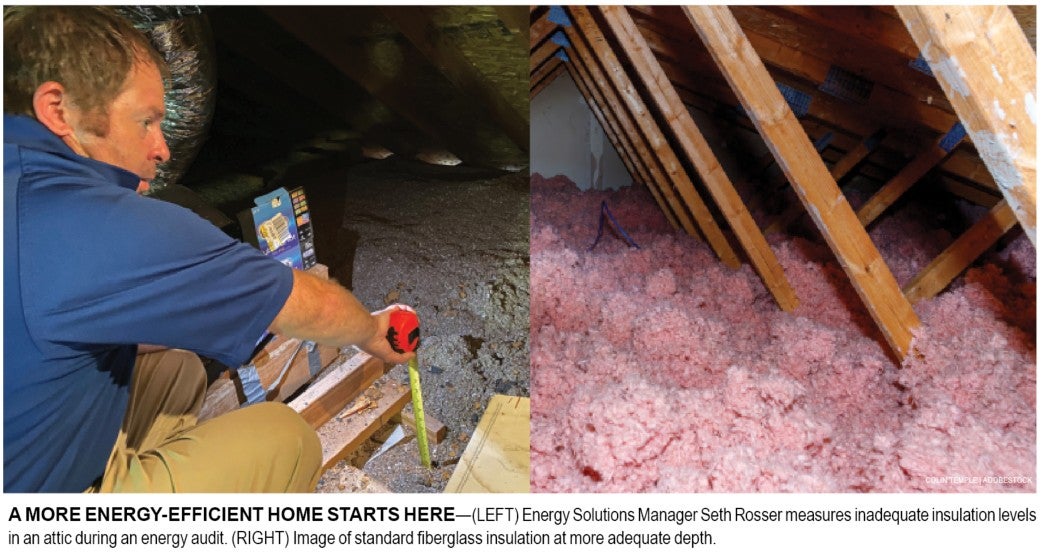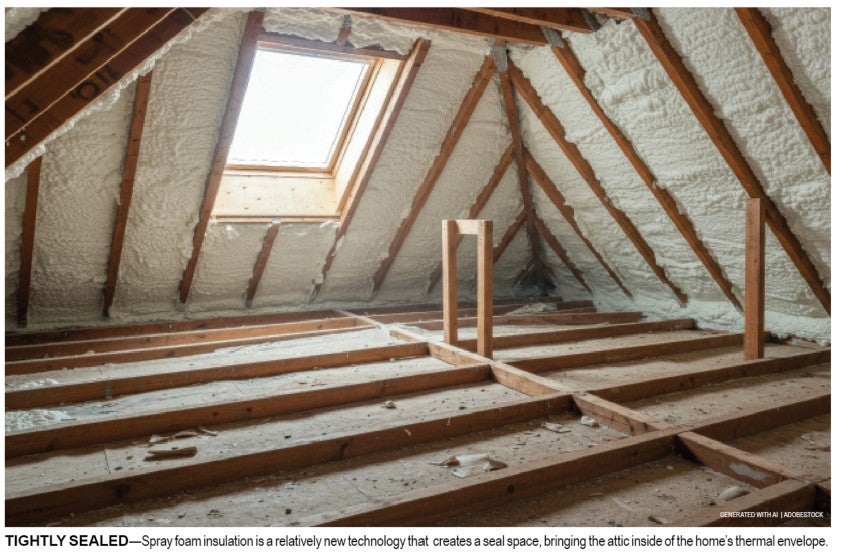The Evolution of Attic Insulation
and How It Impacts Your Energy Bill
by
BRYCE CAVAZOS
When it comes to home comfort and energy savings, what’s above a homeowner’s head matters more than they might think.
Attic insulation—once an afterthought in a dark space visited rarely during the year—plays a major role today in keeping Texas homes cooler in the summer, warmer in the winter and less costly to run year-round.
United’s energy specialists see it all during home energy audits—from attics with only a few inches of aging rockwool insulation to modern, spray-foamed spaces that are tightly sealed. Thrifty homeowners will find the difference is dramatic when it comes to those spaces that are outfitted correctly. Done correctly, they will increase comfort while managing utility bills.
Back When: Too Little, Too Thin
Homes built before the 1980s will most likely have underperforming attic insulation. Air sealing wasn’t part of planning and construction practices then. Often, they sport only a few inches of fiberglass batting, or sometimes even oddball materials like rock wool, sawdust, or shredded paper. These older products offer minimal protection and often shift, settle or get disturbed by pests.
These attics are typically not sealed correctly and are riddled with gaps around light fixtures, ductwork and wiring. The gaps allow hot outdoor air to rush in and cooled indoor air to sneak out, resulting in higher bills and harder-working HVAC systems.
Vintage Blown-In Solutions
By the 1980s and ’90s, builders and homeowners began installing blown-in fiberglass and cellulose. These materials filled gaps more effectively and could be installed quickly. While fiberglass was most common, cellulose products made from recycled paper and treated for fire resistance, gained popularity for its eco-friendly angle and soundproofing qualities. While better in many ways to the nearly-nothing of yesteryear, blown-in insulation has its limits. Because it sits on the attic floor, the space above it remains stiflingly hot in the summer. Any HVAC ductwork or air conditioning equipment located in the attic space bakes in the heat and loses efficiency.

Today’s Standards
Today’s building codes have raised the bar on energy efficiency. Still, United energy solutions specialists will find many homes built as recently as the early 2000s fall tragically short on insulation innovation.
In much of Texas, homes are expected to reach at least R-38 in attic insulation—that equates to about 13 to 14 inches of fiberglass or a foot of cellulose. During energy audits, our specialists often find insulation levels that measure closer to R-19 or R-30—eight to nine inches of fiberglass or cellulose. And in some cases, parts of some attics don’t have insulation at all.
This doesn’t just make an attic hotter, it costs homeowners money. According to the U.S. Department of Energy, upgrading attic insulation can shave 10 to 20 percent off heating and cooling costs. That means anywhere from $200 to $400 in savings each year. Those savings add up to thousands of dollars—often enough to cover the full cost of adding or upgrading attic insulation.
New Technology: Spray Foam
One of the biggest shifts in home design has been the use of spray foam to create a sealed, unvented attic.
Instead of insulating the attic floor, contractors apply foam directly to the roof decking, bringing the attic inside the home’s thermal envelope.
The benefits are easy to see:
-
Lower attic temperatures. HVAC unit is no longer sitting in sweltering heat
-
Fewer leaks. Foam fills cracks and gaps that other insulation misses
-
Better humidity control in hot climates
Spray foam also delivers high insulating power per inch. It comes with higher upfront costs and requires professional installation, but many homeowners find the long-term comfort and energy savings worth it.

Common Problems We See
Even homes that technically have “enough” insulation can lose efficiency due to poor installation or insufficient upkeep. During energy audits, United’s energy specialists often find the following issues in attic spaces:
-
Layers of mismatched materials
-
Insulation pushed aside during repairs and never replaced
-
Loose-fill insulation blown away near soffits or eaves
-
Compressed insulation under storage platforms or walkways
-
Attic hatches left unsealed, allowing conditioned air to escape
Any of these issues can reduce insulation performance by one third or more.
What Can Homeowners Do?
For homeowners wondering about the condition of their attic, a quick check can tell a lot. Grab a flashlight and measuring tape and peek into the attic:
-
Are the tops of ceiling joists visible?
-
That’s a sign the attic doesn’t have adequate insulation.
-
Is the insulation depth less than 10 to 12 inches?
-
Are bare spots, gaps or disturbed areas in the insulation visible? That means attic isn’t performing at its best.
Homeowners will see benefits quickly. Even simple fixes like sealing the attic hatch, adding a few more inches of loose-fill insulation or blocking wind intrusion near eaves can cut energy waste. Pairing these improvements with duct sealing or an HVAC tune-up multiplies the benefits.
For a more thorough evaluation, United offers free home energy audits. Our specialists measure insulation levels, check for air leaks and look at how the HVAC system is impacted. We also provide recommendations and let members know if rebates or incentives are available for upgrades.
Why It Pays Off
Upgrading attic insulation pays off in ways that go far beyond the initial expense. A well-insulated attic makes a home more comfortable, keeping bedrooms cooler at night and living spaces more consistent throughout the day. It also protects the HVAC system by reducing the strain of constant heating and cooling, which can extend its lifespan.
And when the unexpected happens—such as a power outage or an extreme Texas heat wave—a properly insulated attic helps a member’s home stay liveable longer.
The monthly energy savings are just the icing on the cake. Many members report that their summer cooling costs drop by $40–$60 after sealing leaks and boosting insulation levels.
The Bottom Line
Want expert advice on any energy-related issue? United’s Energy Solutions team is here to help with free audits and recommendations. To learn more, click here.


